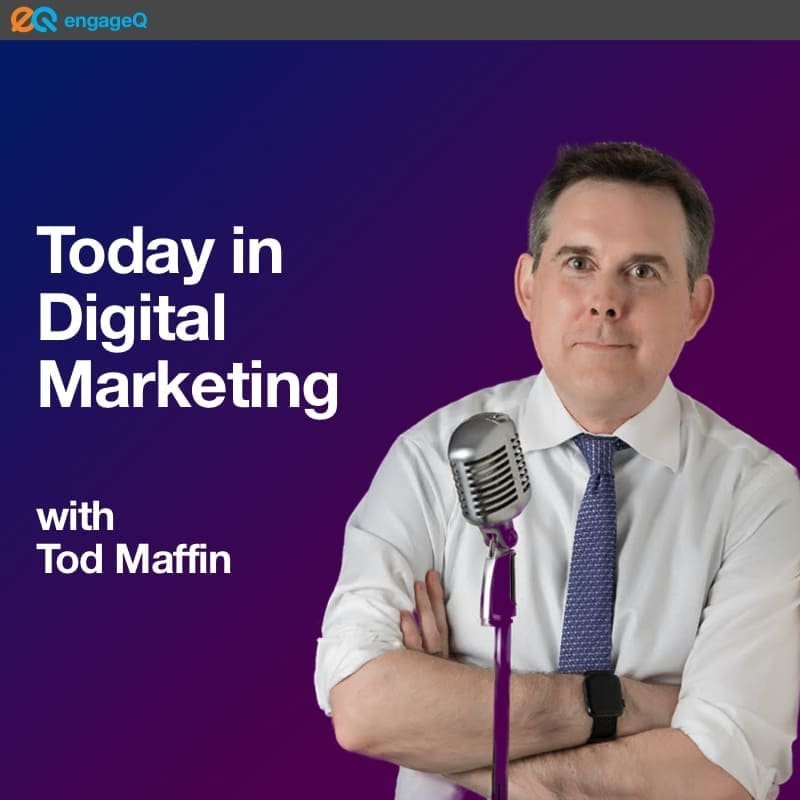In 2017, Microsoft’s video game brand, Xbox went onto social media and congratulated its competitor Nintendo on the launch of its news switch console.
That same year, The New York Times encouraged people to read other news sources like The Wall Street Journal.
The Oreo cookie brand once told its fans how irresistible the competing KitKat chocolate bar was.
As marketers were taught early on that even the mere mention of the existence of a competitor is a bad idea, but have we had it wrong all this time?
Lingrui Zhou is a Ph.D. candidate at Duke University. This month, she and her colleagues published an article in the Journal of Marketing called Befriending the Enemy: The Effects of Observing Brand-to-Brand Praise on Consumer Evaluations and Choices.
She recently spoke to our podcast host, Tod Maffin.
Table of Contents
- Should You Praise a Competitor?
- Warmth and Competence
- It’s Counter-Intuitive
- Why Brand-to-Consumer Praise Fails
- But Do Consumers Really Believe It?
- Study Methodology: Fake Ads
- How Praising Competitors Affects Sales
- Does it Apply to Non-Profits?
Should You Praise a Competitor?
Tod Maffin: Could we first talk a bit about the top-line findings? Is it a good idea for a brand to praise its competitor by name?
Ms. Zhou: Yes. What we actually find in our studies is that observers who see one brand praising another brand form better impressions of the brand doing the praise. It results in better brand attitudes towards that brand and increases sales for the praiser brand.
Warmth and Competence
Tod Maffin: I want to talk about sales in a moment, but your research was anchored by two dimensions that people use to judge others, warmth and competence. Can you talk a bit about both and how they apply to judging brands?
Ms. Zhou: Yes. As you’ve said, warmth and competence are two of the primary dimensions we use to we judge brands when we see them. Warmth is more about the warm and fuzzy feelings that you feel like this brand cares about you, about others, whereas the competence dimension focuses more on the brand’s ability to deliver. What we find in our project is that brand-to-brand praise increases brand warmth. You perceive the brand as being more warm and fuzzy and a brand that you would want to engage with.
Tod Maffin: What about competence though? On the competence side, does it bring into question of– yes, I think you are using the term observers, but the people out there who see this brand-to-brand praise, do they perceive that brand doing the praising to be somehow less competent? Is there a scale that you measured on the competency side?
Ms. Zhou: Yes, we do measure competence as well, and we find that this does not harm perceptions of competence at all, which is great. In some studies, we even find that it increases perceptions of competence as well, although that’s not as consistent as the raises in perceptions of warmth.
It’s Counter-Intuitive
Tod Maffin: Did your findings come as a surprise to you and your colleagues?
Ms. Zhou: It was pretty surprising because it does go against conventional wisdom, right? We see so many attack ads. We never really see as many positive interactions between competitors. Some of the examples you’ve listed are basically some of the only ones we’ve found from brands who do this. It was very surprising for us that viewing positive interaction between brands can result in increased impressions of that brand.
Why Brand-to-Consumer Praise Fails
Tod Maffin: One of the things I found interesting in your paper was you pointed to previous research that brand-to-consumer praise is often seen by consumers in a negative light. For instance, a sales clerk at a clothing store, complimenting a customer on their fashion sense might be perceived as, I don’t know, insincere, because they’re just trying to make a sale, essentially. Why do you think that skepticism doesn’t happen when the praising is between two brands?
Ms. Zhou: We know from existing literature, as you’ve mentioned, that we become skeptical when we feel like the praise is more like flattery, it has an ulterior motive, but when it comes to brand-to-brand praise, we inherently know that these brands are competitors. We know that bringing positive attention to your competitor is a very weird and counterintuitive thing to do and be. We view this action as a very costly action for the praiser. The praiser doesn’t necessarily have any obvious benefits from praising a competitor, so because of this perceived costliness, it’s able to disarm the more skeptical consumers and showcase that this brand really does care about its relationships with others which then leads to increased brand warmth and better brand perceptions.
Tod Maffin: It’s the fact that it potentially could cost the brand something negative, could cost them in market share whatever is the very reason that consumers find it beneficial?
Ms. Zhou: Yes. The consumers really view it as if this is brand is brave enough and cares enough to actually bring attention to their competitors in a positive light, then this brand must really be a warm brand because it’s willing to take such costly actions.
But Do Consumers Really Believe It?
Tod Maffin: Did you study at all whether consumers believe the praise? If Oreo goes on and says– well, let’s use a fictional example, burger chain one goes on to burger chain two and says, “Hey burger chain two, that burger looks like it tastes great.” Do consumers evaluate in their heads whether or not it actually tastes great? Do they believe the accuracy of the messaging or just simply the fact that they did any messaging is what moves the needle?
Ms. Zhou: We didn’t exactly measure if consumers believe the message itself. We did measure whether or not they believe that a brand would engage in this type of praise and in our studies– A lot of consumers in our studies didn’t actually believe that a brand would actually do this but when we see in the real world, when we collected some real-world data, we do find the positive of effects of viewing brand-to-brand praise. The difference between studies and the real world is that in the real world, you don’t have this issue of believability. If it’s out there, then it’s out there.
While we didn’t measure the believability of the actual messages themselves, whether or not praising this burger, is that burger actually good? We do find in a qualitative study that consumers in general, just like the fact that a brand is praising its competitor.
Study Methodology: Fake Ads
Tod Maffin: I like the fact that the metric or the criteria is often the costliness. I think that that makes a lot of sense. You have a great example in your paper about the tale of a male peacock and it’s got, as we all know, a very large and colorful tail, which makes it hard to escape from predators, but that costliness of its inability to escape from predators is exactly what attracts females. I thought that was really interesting. Can you talk a bit about your methodology? You ran Facebook ads for a fake company, is that right?
Ms. Zhou: Yes. In that study, we created a Facebook page about a carwash brand and we tested three sets of ads. In that one, we tested an ad where the focal brand Precision Carwash, which we made up praise another brand and congratulated it for winning an award. In another set of ads we had the focal car brand Precision Carwash, basically praise itself, compliment itself like, “Congratulations to us, we won this award.” Then in the third condition, we actually had an outsider praise the brand. The committee that was giving the award, we also made a Facebook page for them.
We had the committee congratulate our focal brand, the Precision Carwash on winning the award. From these three sets of ads, we find that it was the ad that showed Precision Carwash praising another brand that led to the most clicks for the website.
How Praising Competitors Affects Sales
Tod Maffin: Interesting. Obviously, we marketers measure things in terms of sales. Clicks are great to get good feelings, are great to get, but what we care about is sales. Did you study how praising a competitor might affect purchases?
Ms. Zhou: In the study, consumers saw one of two tweets from KitKat. They either saw a tweet where KitKat complimented itself calling themselves delicious and another tweet in which KitKat praises, competitor Twix.
Tod Maffin: These were fake?
Ms. Zhou: Yes. These were fake tweets that we made up and we just told consumers to imagine. We told participants to imagine that they saw this tweet. Participants were randomly assigned to see either one of those two tweets. Then afterwards, 11 days after we followed up with the participants from that study and we asked them if they’ve made any KitKat or Twix purchases within the past 11 days from when they first took the study. What we actually find is that consumers who saw the KitKat praising Twix message, were about 34% more likely to purchase KitKats compared to those in the control condition.
Importantly, we find that sales for Twix did not increase at all. Praising a competitor really only boosted the praiser brand and didn’t boost the brand who got praised.
Tod Maffin: It seems so countering. It seems against everything in my marketing body. [laughter]
Ms. Zhou: It is really counterintuitive. You can bring positive attention to a competitor, but it actually just boosts your own brand.
Does it Apply to Non-Profits?
Tod Maffin: You suggested that this would work really best for for-profit companies and might not work as well for nonprofit organizations. Why not?
Ms. Zhou: We inherently view nonprofit organizations as more warm and caring compared to for-profit organizations because nonprofits are already perceived as high-end warmth, there’s less room for them to grow in that regard. Even if they saw the nonprofit praise another competitor, it gives a less of a boost in the warmth aspect, whereas for-profit brands have more room to grow in the warmth and perception. Seeing a brand praise another brand that are in the for-profit category, that has the biggest impact on brand warmth, which then leads to better consequences.
Tod Maffin: I see, so it’s the bigger the gap between the perception of warmth that moves the needle.
Ms. Zhou: Right. The more room there is for growth, the better it is. That’s also why skeptical consumers are also experiencing a bigger effect because you can imagine if you’re skeptical, you’re already not that trusting of brands so there’s more room for you to grow in the trust of brands. That’s why brand-to-brand praise also has a bigger impact on skeptical consumers.














